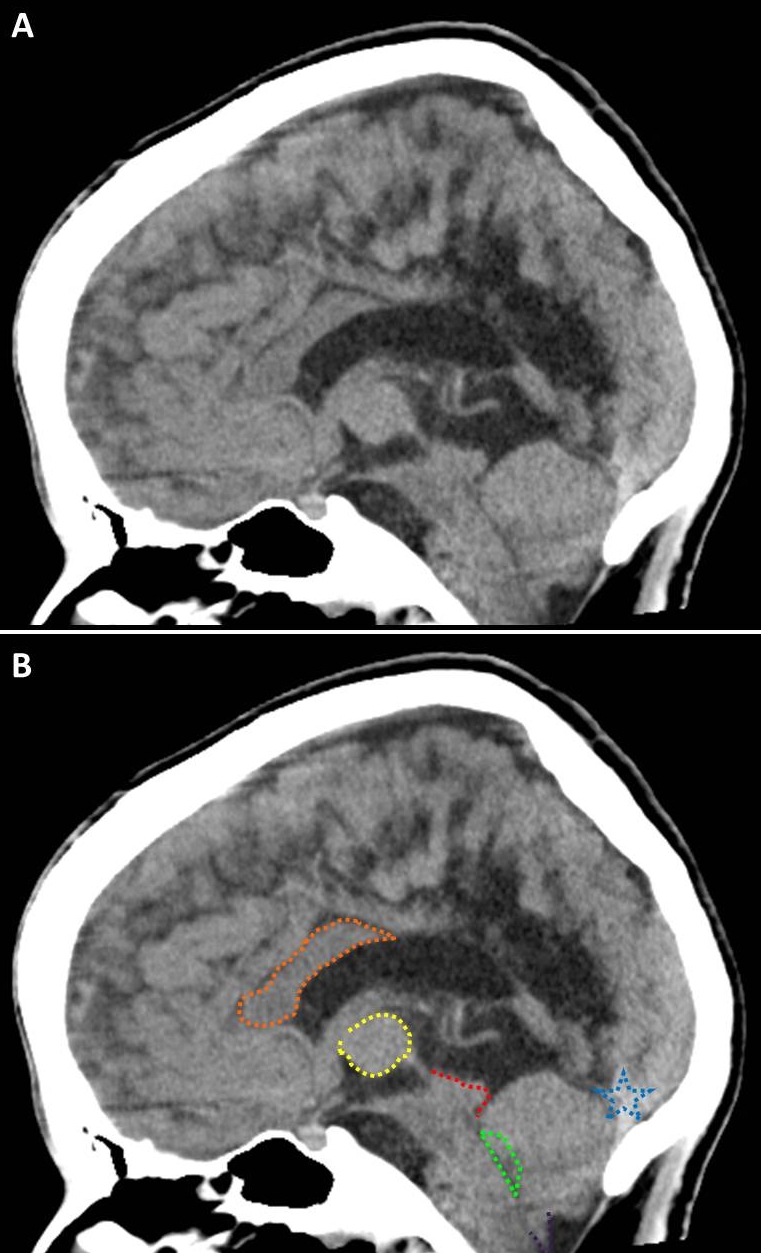Arnold-Chiari malformation CT: Difference between revisions
No edit summary |
No edit summary |
||
| (4 intermediate revisions by the same user not shown) | |||
| Line 3: | Line 3: | ||
{{CMG}} {{AE}} {{Fs}} | {{CMG}} {{AE}} {{Fs}} | ||
==Overview== | ==Overview== | ||
[[CT scan]] may be helpful in the [[diagnosis]] of Arnold Chiari malformation. Findings on [[CT scan]] [[diagnostic]] of Arnold Chiari malformation depends on the subtype and include [[Cerebellar tonsill herniation|herniation of cerebellar tonsils]], [[vermis]], and lower [[brain stem]], underdeveloped [[cerebellum]] and crowded [[foramen magnum]]. | |||
== CT scan == | == CT scan == | ||
CT scan may be helpful in the diagnosis of Arnold Chiari malformation. Findings on CT scan diagnostic of Arnold Chiari malformation depends on the subtype and include: | [[CT scan]] may be helpful in the [[diagnosis]] of Arnold Chiari malformation. Findings on [[CT scan]] [[diagnostic]] of Arnold Chiari malformation depends on the subtype and include:<ref name="pmid26246090">{{cite journal |vauthors=Cotes C, Bonfante E, Lazor J, Jadhav S, Caldas M, Swischuk L, Riascos R |title=Congenital basis of posterior fossa anomalies |journal=Neuroradiol J |volume=28 |issue=3 |pages=238–53 |date=June 2015 |pmid=26246090 |pmc=4757284 |doi=10.1177/1971400915576665 |url=}}</ref><ref name="ForbesIsherwood1978">{{cite journal|last1=Forbes|first1=W. St. C.|last2=Isherwood|first2=I.|title=Computed tomography in syringomyelia and the associated Arnold-Chiari Type I malformation|journal=Neuroradiology|volume=15|issue=2|year=1978|pages=73–78|issn=0028-3940|doi=10.1007/BF00334118}}</ref> | ||
* herniation of: | *[[herniation]] of: | ||
** [[Cerebellar tonsils]] and [[vermis]] | **[[Cerebellar tonsils]] and [[vermis]] | ||
** lower [[brain stem]] | ** lower [[brain stem]] | ||
** Underdeveloped [[cerebellum]] | ** Underdeveloped [[cerebellum]] | ||
* Crowded foramen magnum | * Crowded [[foramen magnum]] | ||
[[File:Chiari-ii-malformation-ct-morphology.jpg|500px|none|thumb|Case courtesy of Dr Charlie Chia-Tsong Hsu, Radiopaedia.org, rID: 18557|https://radiopaedia.org/cases/chiari-ii-malformation-ct-morphology]] | [[File:Chiari-ii-malformation-ct-morphology.jpg|500px|none|thumb|Case courtesy of Dr Charlie Chia-Tsong Hsu, Radiopaedia.org, rID: 18557|https://radiopaedia.org/cases/chiari-ii-malformation-ct-morphology]] | ||
<br />In the CT scan picture above: | <br />In the [[CT scan]] picture above: | ||
* Red: tectal beaking | * Red: tectal beaking | ||
* Orange: corpus callosum dysgenesis | * Orange: [[corpus callosum]] [[dysgenesis]] | ||
* Yellow: large mass intermedia | * Yellow: large mass intermedia | ||
* Green: absence of fastigium | * Green: absence of fastigium | ||
* Blue: low-lying tentorium/torcular | * Blue: low-lying [[tentorium]]/torcular | ||
* Purple: vermian ectopia | * Purple: vermian ectopia | ||
==References== | ==References== | ||
Latest revision as of 00:52, 19 September 2019
|
Arnold-Chiari malformation Microchapters |
|
Differentiating Arnold-Chiari malformation from other Diseases |
|---|
|
Diagnosis |
|
Treatment |
|
Case Studies |
|
Arnold-Chiari malformation CT On the Web |
|
American Roentgen Ray Society Images of Arnold-Chiari malformation CT |
|
Risk calculators and risk factors for Arnold-Chiari malformation CT |
Editor-In-Chief: C. Michael Gibson, M.S., M.D. [1] Associate Editor(s)-in-Chief: Fahimeh Shojaei, M.D.
Overview
CT scan may be helpful in the diagnosis of Arnold Chiari malformation. Findings on CT scan diagnostic of Arnold Chiari malformation depends on the subtype and include herniation of cerebellar tonsils, vermis, and lower brain stem, underdeveloped cerebellum and crowded foramen magnum.
CT scan
CT scan may be helpful in the diagnosis of Arnold Chiari malformation. Findings on CT scan diagnostic of Arnold Chiari malformation depends on the subtype and include:[1][2]
- herniation of:
- Cerebellar tonsils and vermis
- lower brain stem
- Underdeveloped cerebellum
- Crowded foramen magnum

In the CT scan picture above:
- Red: tectal beaking
- Orange: corpus callosum dysgenesis
- Yellow: large mass intermedia
- Green: absence of fastigium
- Blue: low-lying tentorium/torcular
- Purple: vermian ectopia
References
- ↑ Cotes C, Bonfante E, Lazor J, Jadhav S, Caldas M, Swischuk L, Riascos R (June 2015). "Congenital basis of posterior fossa anomalies". Neuroradiol J. 28 (3): 238–53. doi:10.1177/1971400915576665. PMC 4757284. PMID 26246090.
- ↑ Forbes, W. St. C.; Isherwood, I. (1978). "Computed tomography in syringomyelia and the associated Arnold-Chiari Type I malformation". Neuroradiology. 15 (2): 73–78. doi:10.1007/BF00334118. ISSN 0028-3940.